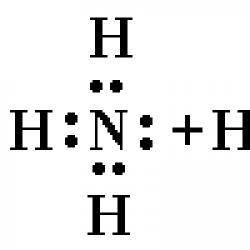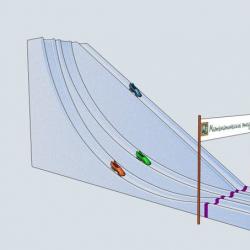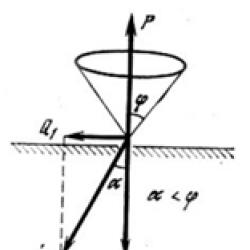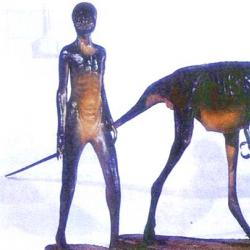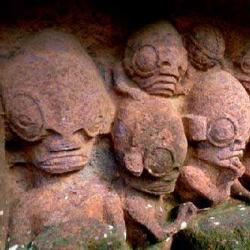The meaning of the word paraphrase. The meaning of the word periphrase in the dictionary of literary terms Example of periphrase in Russian
“Periphrase” or “periphrase” is an interesting phenomenon in the Russian language. It belongs to the category of tropes - stable combinations of artistic speech, used semantically indivisibly and everywhere. This article will help us understand what a periphrase is.
In contact with
Classmates
Periphrasis is a term that came from Ancient Greece, translated means: “peri” - around, “phraso” - I say. That is, “to talk about” - to describe an object or phenomenon using associated words with elements of allegory, with the designation of signs or features. That is, if we give a definition to periphrase, then we can say that this term implies paraphrasing and a special interpretation.
Examples
Allegorical storytelling embellishes the Russian language, making it more figurative, interesting and vibrant. Saying the word “fox” is not the same as saying “cunning beast,” although both options refer to the same object. Periphrasis allows you to add brightness and the speaker’s own attitude to the characterization of someone or something.
A person who uses a paraphrase adds to the description of an object or phenomenon a whole range of features that characterize it in a special way. Moreover, for any person these moments will be recognizable. For example: “ship of the desert” - camel, “blue planet” - Earth, “our little brothers” - fauna, “City on the Neva” - St. Petersburg.
In our speech we often resort to allegorical periphrases without noticing it ourselves.. Here are some examples:
- “I left for Belokamennaya” (Moscow).
- “Extract black gold” (oil).
- “Exclude white death from your food” (sugar).
- “A sad time is coming” (autumn).
What are the types of paraphrases?
 Periphrases in the Russian language are divided into two categories: general language and author’s. The former are used everywhere in the form of allegories for objects known to everyone: “king of beasts”, “blue screen”.
Periphrases in the Russian language are divided into two categories: general language and author’s. The former are used everywhere in the form of allegories for objects known to everyone: “king of beasts”, “blue screen”.
The author's periphrases belong to writers and poets who once used them and the phrases became stable figures of speech: “Peter’s creation,” “mirror of the Russian revolution.” Periphrases are recognizable and all educated people, native speakers, understand what or who is meant.
Periphrases are divided into two more categories: logical and figurative. The first ones have a clear connection between descriptive properties: “feathered friends”, “cunning red face”. In the second category, figurative periphrases (they are classified as tropes) have an associative structure of connection of descriptive characteristics. This is what you can say about a person: “Plyushkin” (stingy, greedy), “she eats like Thumbelina” (very little).
The expressiveness and beauty of the Russian language was admired by Lomonosov, Derzhavin, Gogol, Turgenev, Tolstoy and many other writers, poets, whose life and creative activity were directly connected with the word. They noted its euphony, rich, varied vocabulary, expanded semantics, which allowed them to so skillfully use all figurative and expressive means.
Introduction to the concept
What is such a linguistic phenomenon as periphrasis? We see examples of it quite often both in everyday communication and in artistic speech. If you hear someone say “queen of the night” or “night luminary” instead of the word “moon”, and instead of “stars” - “guiding lights”, “pearls” and “precious placers”, then know that they collided with the mentioned concept. In art, it was singled out by the ancient Greeks, who also gave it a definition: “an expression that describes one phenomenon with the help of another.” That is, an allegory, “one thing instead of the other” - this is how “periphrase” literally sounds in Greek. Examples of such “around the bush” (another translation-interpretation) are quite easy to find. Well, at least Pushkin’s famous appeal to the sea: “Farewell, free elements!”
Periphrase - paraphrase
What is discussed in the article is often confused by people ignorant of artistic paths with paraphrase - a word that is very similar in sound, but has a completely different meaning. This term denotes different types of retelling of the text: detailed, abbreviated, adapted, translations from poetry into prose and vice versa. It also includes various comments, including scientific texts. Periphrasis has a completely different purpose. Examples of it in speech are in many ways similar to the role of pronouns in grammar. Both linguistic phenomena do not name objects or signs, but point to them: “he” instead of “man” and “one-armed bandit” instead of “slot machine”.
Speech expressiveness

There are quite a lot of tropes in literary studies that descriptively express some concepts with the help of others. These are metaphors, puns, and comparisons. Periphrasis occupies a special place among them. Examples identified in colloquial speech make it possible to classify the phenomenon into logical and figurative subgroups. In logical, the descriptive moment is built on explicit, visible, easily distinguishable connections between objects, phenomena, and events. And in figurative ones - on a system of associations and hidden unifying links. What is a logical periphrasis? Examples in Russian are quite easy to find. This is “the author of “A Hero of Our Time” instead of “Lermontov”, and “green spaces” instead of “plants”. Their distinctive feature is their wide distribution, transparency of lexical meaning, and stereotypical reproduction.
The art of words
A slightly different kind of figurative paraphrase. Examples from fiction help to reveal its essence as accurately as possible. If you call someone Oblomov, it becomes clear that this refers to such human qualities as laziness, lack of desire to do anything, idle daydreaming. Plyushkin has long become synonymous with stinginess in its highest manifestations; native speakers of the Russian language often call Moscow “White Stone,” and St. Petersburg in the words of Pushkin: “Peter’s creation.” In this case, we are not dealing with periphrasis in its pure form, but with its fusion with other tropes: metaphor and comparison. They are often realized (that is, having lost their pronounced figurative meaning), expanded or hidden.

Two in one
What else is interesting about periphrasis? Examples from the literature prove its connection with another linguistic phenomenon - euphemism, or more precisely, the imposition of one concept on another. In what cases does this happen? If it is necessary to replace a rude, stylistically reduced word with another, more “noble” one. For example, instead of “cough,” they say “clear your throat,” and instead of “fart,” they say “spoil the air.” A prostitute is called a “woman of easy virtue”, “hetaera”, “representative of the most ancient profession”, “Messalina”. The process of cleansing the nasal sinuses is a beautiful expression “use a handkerchief,” etc. Euphemisms appeared and became entrenched in the language at a time when its literary norms were actively being formed, and there was a struggle for purity and correctness. Lomonosov, with his theory of the “three calms,” drew a sharp line between “high,” “medium,” and “low” vocabulary. It was believed that refined and educated nobles should not use rudeness in their speech. And although Lomonosov’s teaching primarily concerned

literature, genres and genres, it has found the widest application in society.
There is another reason for the appearance of euphemisms: periphrasis is subjective in nature and is determined by religious and cult factors. For example, instead of “devil” in Rus', especially among the people, it was customary to say “unclean” or “evil.” It was believed that such names would not attract excessive attention from otherworldly forces to people, and they, in turn, would not annoy “God’s souls.” In the same way, the peasants did not say the word “brownie” out loud, calling him “master”, “grandfather”, “helper”. The word “Himself” came up quite often. They believed that otherwise the brownie would be offended and we would begin to play dirty tricks on them. And if you call it “correctly,” then in this way you can appease the spirit, which will definitely bring good luck to your home.
Paraphrases are divided into:
- general language (understandable to most, popular in a certain period of time),
- individually-authored.
Commonly used and understandable periphrases include the allegorical names for a lion - “king of beasts”, children - “flowers of life”, television - “blue screen”.
One of the striking examples of periphrasis, understandable to many, are such names of St. Petersburg as “City on the Neva”, “Northern Venice”, “Northern Capital” or “Northern Palmyra”. And as an individual author’s trope, we can name the “Peter’s creation” trope by Alexander Pushkin (“I love you, Peter’s creation”).
Features of the construction of periphrases.
The feature by which the periphrasis is created must be inherent in the defined object or phenomenon, understandable to many people. This trope allows the author to emphasize one side of what is being described, relegating the rest to the background. For example, autumn in Pushkin’s poems turned into a “sad time” and “charm of the eyes.”
A feature of periphrasis is its semantic unity. That is, such statements and phrases cannot be broken or a word changed in them. Thus, the trope becomes a phraseologically related phrase that is understandable to most native speakers.
Periphrases often found in the media and oral speech:
- ship of the desert - camel;
- black gold – oil;
- office rat - official;
- second bread - potatoes;
- the eternal city - Rome;
- third Rome - Moscow.
- blue planet - Earth;
The role of the trope in speech.
The use of periphrasis in literary texts, journalistic materials and speeches of speakers allows us to enhance the expressiveness of the statement, making it more vivid, memorable, catchy.
Examples of paraphrase.
Examples from fiction.
Periphrasis is a figurative and expressive means of speech, therefore it is used in works of art of any kind: in epic, lyricism and drama.
Alexander Pushkin called William Shakespeare “the creator of Macbeth”, and George Byron – “the singer of Giaour and Juan”.
Mikhail Lermontov in the famous obituary “The Death of a Poet,” written for the death of Alexander Pushkin, used a lot of allegories, never calling his colleague by name or surname: “the poet is a slave of honor,” “a wondrous genius,” and “a solemn wreath.”
Periphrase(sometimes also written: paraphrase) is quite close in form to metonymy. Periphrasis is an indirect mention of an object by describing it. For example, not the moon is the night luminary. If in metonymy we replace a word with another word based on a cause-and-effect relationship, then no such connection can be traced here. In periphrasis, there is evaluativeness and subjectivity. For example, saying that Pushkin is “ the sun of Russian poetry", we express a certain attitude towards the great poet. A paraphrase is always a descriptive phrase.
In a paraphrase, the names of objects and people are replaced by characteristics of their essential features. For example, in the works of classicists, sentimentalists and early realists in first-person narratives, “I” was often replaced by the descriptive phrase “the writer of these lines.” Instead of “lion” it is appropriate to write “king of beasts” (because he is the strongest), instead of “fall asleep” - “fall into sleep”, instead of “fountain pen” - “self-writing pen”...
The presence of paraphrases makes the speech slightly pompous and florid. This is something to consider if you decide to use them in a poem. Especially Periphrases are appropriate in the speech of characters and for stylization. Well, and of course, to avoid repetition of words.
Eat logical paraphrases(in structure they are closer to metonymy), for example, “the author of “The Master and Margarita” instead of “Bulgakov”, and figurative paraphrases, for example, “slave of honor” instead of “Pushkin” (the paraphrase belongs to Lermontov).
By the way, it is convenient to use logical paraphrases when evaluating the author’s work. In order not to use “Pushkin” all the time, Vissarion Belinsky, in a series of articles about “Eugene Onegin,” wrote from time to time: “The author of “Eugene Onegin.” The same technique can be adopted by schoolchildren who analyze lyrical works.
A type of paraphrase is euphemism. We call euphemisms such neutral words and phrases that replace reduced or slang vocabulary, or neutral words with special semantics when they want to soften the effect. For example, instead of “blow your nose,” they say: “brush your nose,” and instead of the basically neutral “died,” they use a more “gentle” euphemism: “passed away,” “passed away into another world.”
Periphrasis, or Periphrase [Greek. perifrasis] is a syntactical-semantic figure consisting of replacing a one-word name of an object or action with a descriptive multi-word expression. There are several types of periphrasis:
I. As a grammatical figure:
A) the property of an object is taken as a control word, and the name of the object is taken as a controlled word: “The poet used to amuse the khans poems like rattling pearls"(a paraphrase of the word "verses");
b) the verb is replaced by a noun formed from the same stem with another (auxiliary) verb: "an exchange is being made" instead of "exchanges".
II. As a stylistic figure:
C) the name of the object is replaced by a descriptive expression, which is an expanded trope (metaphor, metonymy, etc.): “send to me, in the language of Delisle, twisted steel piercing the tarred head of the bottle, i.e., a corkscrew” (Pushkin’s letter to his brother).
Here are examples of periphrases: “people in white coats” (doctors), “red cheat” (fox), “king of beasts” (lion), “blue screen” (TV), “night star” (moon).
Periphrases were most commonly used at a time when the selection of vocabulary was strictly applied and simple words were considered unpoetic. The use of periphrases was especially developed during the period of late classicism in the 18th century and persisted at the beginning of the 19th century. Periphrases are often found in M. Lomonosov:
The art for which Apelles was famous
And to whom Rome has now lifted up her head,
Since the benefits of Glass have been great,
This is proven by Finifty, Mosaics...
(“Letter on the Benefits of Glass,” 1752).
Here the first two verses are a periphrasis, which means "painting".
Summary of a Russian language lesson in 10th grade on the topic:
Periphrasis as a means of artistic expression.
Target: acquaintance with such a means of artistic expression as PERIPHRASE (PERIPHRASE)
Developing skills in finding paraphrases in text.
Preparation for the Unified State Exam.
Lesson plan:
- Theoretical material on the topic: periphrasis.
- Consolidation. Finding paraphrases in examples from literature.
- Examples of tasks from the Unified State Exam.
1. There are quite a lot of tropes in literary studies that descriptively express some concepts with the help of others. These are metaphors, puns, and comparisons. Periphrasis occupies a special place among them.
Periphrasis is a trope that consists of replacing a word or name with a descriptive phrase indicating their essential features, qualities, and features. Here is an example from A.S. Pushkin’s novel “Eugene Onegin”:
Although we know that Evgeniy
I have long ceased to love reading,
However, several creations
He excluded from disgrace:
Singer Gyaur and Juan(instead of Byron, author of the poem “The Giaour”
Yes, there are two or three more novels with him...and the novel in verse "Don Juan")
PERIPHRASE - replacing a word or phrase with a figure of speech that indicates the characteristics of an unnamed object(St. Petersburg - the northern capital, a city on the Neva).
Instead of directly naming an object or phenomenon, a poet or writer often resorts to its description.
A) the property of an object is taken as a control word, and the name of the object is taken as a controlled word: “The poet used to amuse the khans of poetry with rattling pearls” (a paraphrase of the word “verse”);
B) the verb is replaced by a noun formed from the same stem with another (auxiliary) verb: “an exchange is made” instead of “is exchanged.”
As a stylistic figure:
C) the name of the object is replaced by a descriptive expression, which is an expanded trope (metaphor, metonymy, etc.): “send me, in Delisle’s language, a twisted steel piercing the tarred head of the bottle, i.e., a corkscrew” (Pushkin’s letter to his brother) .
More examples:
night luminary = moon
or
I love you, Petra's creation! =
I love you, St. Petersburg!"
“king of birds” instead of “eagle”, “king of beasts” - instead of “lion”,“people in white coats” (doctors), “red-haired cheat” (fox), “blue screen” (TV).
General linguistic periphrases usually acquire a stable character. Many of them are constantly used in the language of newspapers:people in white coats (doctors). Stylistically, a distinction is made between figurative and non-figurative periphrases, cf.:The sun of Russian poetry and the author of “Eugene Onegin” (V.G. Belinsky).
Periphrases were most commonly used at a time when the selection of vocabulary was strictly applied and simple words were considered unpoetic. The use of periphrases was especially developed during the period of late classicism in the 18th century and persisted at the beginning of the 19th century.
Examples identified in colloquial speech and literary texts make it possible to classify the phenomenon into logical and figurative subgroups. In logical, the descriptive moment is built on explicit, visible, easily distinguishable connections between objects, phenomena, and events. And in figurative ones - on a system of associations and hidden unifying links. What is a logical periphrasis? Examples in Russian are quite easy to find. This is “the author of “A Hero of Our Time” instead of “Lermontov”, and “green spaces” instead of “plants”. Their distinctive feature is their wide distribution, transparency of lexical meaning, and stereotypical reproduction.
A slightly different kind of figurative paraphrase. Examples from fiction help to reveal its essence as accurately as possible. If you call someone Oblomov, it becomes clear that this refers to such human qualities as laziness, lack of desire to do anything, idle daydreaming. Plyushkin has long become synonymous with stinginess in its highest manifestations; native speakers of the Russian language often call Moscow “White Stone,” and St. Petersburg in the words of Pushkin: “Peter’s creation.” In this case, we are not dealing with periphrasis in its pure form, but with its fusion with other tropes: metaphor and comparison. They are often realized (that is, having lost their pronounced figurative meaning), expanded or hidden. Two in one
What else is interesting about periphrasis? Examples from literature and colloquial speech prove its connection with another linguistic phenomenon - euphemism, or more precisely, the imposition of one concept on another. In what cases does this happen? If it is necessary to replace a rude, stylistically reduced word with another, more “noble” one. For example, instead of “cough,” they say “clear your throat.” A prostitute is called a “woman of easy virtue”, “hetaera”, “representative of the most ancient profession”, “Messalina”. The process of cleansing the nasal sinuses is a beautiful expression “use a handkerchief,” etc. Euphemisms appeared and became entrenched in the language at a time when its literary norms were actively being formed, and there was a struggle for purity and correctness.
Euphemism- a type of paraphrase. Euphemisms replace words whose use by the speaker or writer for some reason seems undesirable.
Lomonosov, with his theory of the “three calms,” drew a sharp line between “high,” “medium,” and “low” vocabulary. It was believed that refined and educated nobles should not use rudeness in their speech. And although Lomonosov’s teaching primarily concerned literature, genders and genres, it found the widest application in society.
There is another reason for the appearance of euphemisms: periphrasis is subjective in nature and is determined by religious and cult factors. For example, instead of “devil” in Rus', especially among the people, it was customary to say “unclean” or “evil.” It was believed that such names would not attract excessive attention from otherworldly forces to people, and they, in turn, would not annoy “God’s souls.” In the same way, the peasants did not say the word “brownie” out loud, calling him “master”, “grandfather”, “helper”. The word “Himself” came up quite often. They believed that otherwise the brownie would be offended and we would begin to play dirty tricks on them. And if you call it “correctly,” then in this way you can appease the spirit, which will definitely bring good luck to your home.
2. Find examples in fiction.
Examples of paraphrasefrom the works of A.S. Pushkin:
1.Forgive me, Northern Orpheus
What's in my funny story
Now I'm flying after you. ("Ruslan and Ludmila")
2. She rested in eternal sleep. ("Ruslan and Ludmila")
3. All of us let's descend under the eternal vaults. (“Do I wander along noisy streets”)
4. My path is sad. Promises me work and grief
The coming troubling sea. ("Elegy")
5.Until Morpheus arrives . ("Eugene Onegin")
6. Smile gloomy nature
Through a dream he meets morning of the year. ("Eugene Onegin")
7. Meanwhile, as we Enemies of Hymen,
In home life we see alone
A series of tedious pictures
8. Is it really really true?
Without elegiac undertakings
The spring of my days has flown away.
9. O Romulus family , tell me, how long have you fallen?
10. I escaped the aesculapius
Thin, shaved - but alive;
His tormenting paw
Doesn't weigh down on me.
Answers: Northern Orpheus - Zhukovsky, rested in eternal sleep - died, let's go down under the eternal vaults - we'll die, the exciting sea of the future - future life, Morpheus will fly - we'll fall asleep, the morning of the year - spring, Hymen's enemies - convinced bachelors, the spring of my days - youth, Romulus clan - Romans: Romulus, according to legend, one of the founders of Rome), escaped from Aesculapius - recovered.
A. Tvardovsky.
1. And hidden among the trees,
Having lined up decorously,
Howls and hums together
Bee town. (=beehive)
2. And suddenly find yourself in Siberia
At a semi-unknown point
What's in it for you sublunary world -(=on earth)
From now on, the house and address are yours.
- Unified State Examination tests 2015.
Internet sources:
Literature5.people.ru.

